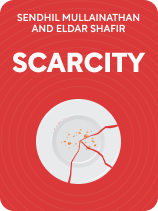

This article is an excerpt from the Shortform book guide to "Scarcity" by Sendhil Mullainathan and Eldar Shafir. Shortform has the world's best summaries and analyses of books you should be reading.
Like this article? Sign up for a free trial here.
What is a scarcity mentality? How does being in a state of scarcity affect your mental state?
When we’re in a state of scarcity (e.g. lacking time or money), we work more efficiently and make decisions more rationally. However, scarcity also pushes us to make trade-offs that can be costly in the long run.
Here’s a look at the psychological effects of scarcity, according to behavioral science researchers Sendhil Mullainathan and Eldar Shafir.
Scarcity Decreases Our Mental Bandwidth
Although scarcities of time and money provide some benefits, Mullainathan and Shafir argue that we severely underestimate the downside of scarcity, the toll on our mental capacity that they call a “bandwidth tax.” Mental bandwidth is a term that encompasses our cognitive capacity and executive brain function. These concepts boil down to our ability to pay attention to important events, process information, make good decisions, and resist temptations.
(Shortform note: One education program uses physical energy as an analogy for understanding our limited mental bandwidth: When we’re physically fatigued, we’re more prone to injury and less physically efficient. Similarly, when our mental bandwidth is low, we’re less mentally engaged, less productive, and more prone to making errors.)
Mullainathan and Shafir assert that the same scarcity that gives us laser focus on pressing matters leaves us with little mental bandwidth to do other things in our life well. This hijacking of our mental bandwidth impacts us in three major ways: It makes us neglect other important areas of our life, decreases cognitive performance, and encourages borrowing habits to meet immediate needs—habits that then exacerbate and complicate the initial scarcities.
Scarcity Makes Us Neglect Other Areas of Our Life
When our brains are focused on dealing with a scarcity of time or money (and remember this hyperfocus is involuntary and thus out of our control), our decreased mental bandwidth causes us to neglect other aspects of our life that we genuinely care about.
For example, Mullainathan and Shafir point out that when we can’t stop thinking about our to-do list, it prevents us from being present with our loved ones. When we feel busy, we tend to cut out exercise from our schedule or decide we don’t have time to prepare a healthy meal, and we let other things fall by the wayside that we value as important to our well-being. Similarly, when we’re focused on making ends meet at the end of the month, scarcity becomes a distraction from work, family, or even simple tasks like driving.
(Shortform note: In Indistractable, Nir Eyal says you can avoid neglecting important aspects of your life by building a schedule centered around three key areas: you, your work, and your relationships. Eyal suggests defining your values in these areas as well, like being engaged with loved ones or expressing creativity at work. By defining your values and actively tracking your time spent in the three key areas, you can assess if your schedule is balanced and aligned with what you most care about.)
Lower Cognitive Performance
Mullainathan and Shafir also argue that financial scarcity (and the resulting mental bandwidth shortage) decreases our cognitive performance. In one of the authors’ studies, people did significantly worse on an IQ test when they were given a difficult financial scenario to figure out before the test. This showed how the scarcity mentality decreased performance when people had to make a decision about a difficult trade-off.
Because the subjects were randomly selected (not necessarily poor or rich) and the researchers compared IQ scores in individuals, the data supports the idea that scarcity causes lower cognitive function, and not the other way around. This research on the impact of financial scarcity, along with other similar studies by Mullainathan and Shafir, is the basis for their theory that a mental bandwidth shortage, caused by scarcity, is what keeps people in poverty.
(Shortform note: Mullainathan and Shafir’s research contradicts many other explanations for why people struggle to escape poverty. For example, T. Harv Eker claims in Secrets of the Millionaire Mind that poor people mismanage their money because they have a negative attitude. Similarly, in When Helping Hurts, Steve Corbett and Brian Fikkert claim that poor people make bad financial decisions because of their negative view of God, themselves, other people, and the rest of creation. While it’s difficult to disprove the idea that negative thinking plays some role in people’s actions, Mullainathan and Shafir’s research indicates that scarcity is at least one factor that temporarily decreases cognitive performance.)
Borrowing Habits Exacerbate Scarcity
Mullainathan and Shafir assert that scarcity of time and money also burdens us by fostering unwise borrowing habits. In the context of time, people “borrow” when they procrastinate on tasks that will take longer later on and take shortcuts that have a higher long-term cost. In a financial context, borrowing involves taking out loans that lead to debt.
These are all forms of what the authors call “scarcity traps”: feedback loops where our low mental bandwidth causes us to fall farther and farther behind on time or money, and the scarcity builds on itself. Thus, the initial scarcity is a matter of chance or systemic conditions (like being born into poverty or facing cultural expectations for high work productivity), but then our bandwidth shortage causes us to further exacerbate the scarcity.
Mullainathan and Shafir explain that when we have less mental bandwidth, we lose the executive function that weighs decisions carefully because they’re outside of the narrow focus caused by scarcity. Researchers refer to this phenomenon as “present bias.” (Shortform note: Some people argue that in addition to causing present bias in everyday activities, profit-driven business models foster a scarcity mindset, leading to present bias in corporate settings. This causes employees to make decisions for short-term profit boosts without considering long-term impacts on environmental or financial sustainability.)
In the rest of this section, we’ll discuss how scarcity can lead to procrastination and financial debt, both of which exacerbate the initial scarcity.
Procrastination
People with scarce time engage in a form of borrowing when they procrastinate on things that will take longer later and opt for quick fixes to problems. In these scenarios, our scarcity-handicapped brains can’t recognize that ignoring important tasks is likely to increase scarcity.
For example, if you procrastinate on cleaning out your email inbox, it becomes a more time-consuming task with each passing day as more emails keep coming in. Therefore, over time, you’re likely to keep procrastinating and the time cost keeps increasing.
The authors write that another form of procrastinating involves taking shortcuts by doing a “quick fix.” The quick solution helps you manage a tight schedule in the short term but will only be a temporary bandage for something that will get more expensive or more time-consuming to fix later. For example, if you patch a leaky pipe instead of replacing it, you’re likely to have major water damage and many more maintenance issues than you started with when the patch fails.
(Shortform note: These examples boil down to the idea of overvaluing efficiency over effectiveness. In The 4-Hour Workweek, Tim Ferriss defines effectiveness as doing important things that help you achieve good results, whereas he defines efficiency as doing things the fastest way possible, regardless of their importance. Organizing or clearing your overfull inbox may take up precious time, but it’s an important task if it helps you communicate better and get your work done. In this case, ignoring the inbox chaos is efficient but ineffective. Likewise, patching a leaky pipe is more efficient than a full replacement, but it’s ineffective if the end result is extensive water damage.)
Financial Debt
Mullainathan and Shafir also discuss the ways that people often spiral into debt when they’re unable to meet their basic needs. They write that poor people are particularly susceptible to taking out payday loans. A payday loan is generally a short-term, high-cost loan that gives people access to quick cash when they need it before their payday. It offers an easy solution to urgent problems presented by scarcity—things like making a car payment, keeping the lights on, paying the rent, and buying groceries.
Mullainathan and Shafir explain that although payday loans solve the problem temporarily, people end up paying compounding interest on loans because they’re unlikely to pay them off. Each month, they’ll have the same expenses plus the loan fees, so the fees roll over, and the loans get increasingly difficult to pay off. The authors note that sometimes it’s worth it to take out a loan when we really will have more resources later, or it’s simply a matter of timing, and we can pay it off soon. However, with limited bandwidth, we don’t have the capacity to analyze the long-term consequences of the loan and make a rational decision.
| The Payday Loan Landscape in the US Supporting Mullainathan and Shafir’s argument that payday loans are a solution to urgent unmet needs in poor populations, research shows that 70% of payday loan borrowers use the money for basic monthly expenses such as utilities. In addition, 75% of borrowers take out at least 10 loans per year, suggesting that people use them for ongoing expenses and not just for emergencies (as they’re primarily marketed). Payday loan services are also more concentrated in areas with high levels of poverty, making them highly accessible and therefore more appealing to those in the scarcity mindset. Another key factor in payday loan demographics is age. The majority of borrowers are 18-24 years old, which may be partly due to the rising debt crisis among young people. Young adults also have lower average credit scores, which limits their borrowing options. Payday loans don’t require any credit score, unlike more traditional, low-interest bank loans that do require a minimum credit score. Since the book was published, three presidential administrations in the US have changed regulations on payday loans. The Obama administration barred interest rates higher than 400% and required lenders to determine if the borrower could repay the loan as well as cover their basic expenses. The Trump administration ended these protections, and this decision was then reversed during the Biden administration. |

———End of Preview———
Like what you just read? Read the rest of the world's best book summary and analysis of Sendhil Mullainathan and Eldar Shafir's "Scarcity" at Shortform.
Here's what you'll find in our full Scarcity summary:
- An exploration of the good and bad sides of a scarcity mindset
- Strategies to counteract the negative cognitive effects of scarcity
- How policymakers should redesign social programs






